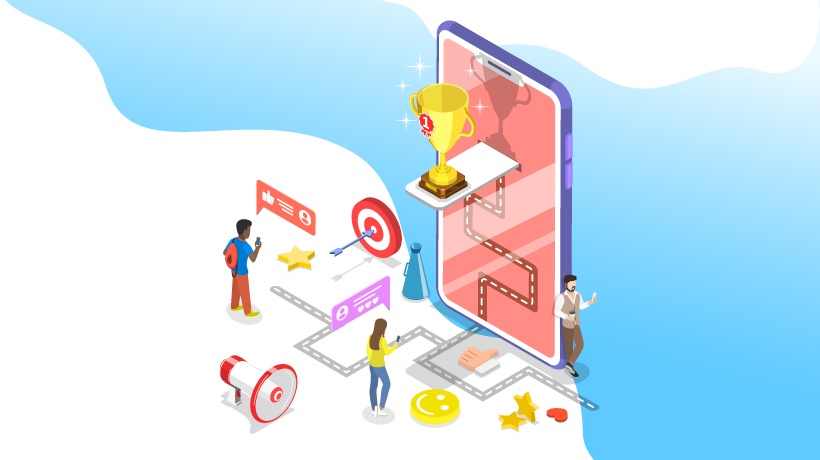Using Gamification Strategies To Grow Businesses
Gamification, a relatively unknown term until a couple of years ago, was first introduced in 2008 by Brett Terrill in a blog covering his time at the 2008 Social Gaming Summit. In Brett’s words, gamification is "taking game elements and applying them to a non-gaming context." Even a decade later, Brett’s definition of gamification still rings true. Companies now use gamification as an effective method to grow their business and engage new users into using their product or service. By using points, ranks, badges, and leaderboard mechanisms that present an element of competition and achievement, companies entice customers into participating.
How Gamification Can Help Increase eCommerce Business Revenue?
Ever since COVID-19 limited companies, organizations, and businesses to performing operations online rather than in person, experts saw a decline in traditional shopping. Surprisingly, the eCommerce industry witnessed a tremendous boost. Companies like Amazon, Google, among others saw unparalleled growth in their revenue numbers. With growing competition, businesses started focusing more on ways to capture the attention of a newer audience. One of those ways is gamification.
Gamification became one of the most discussed topics of this year, and rightfully so. Websites that added game mechanics to engage users into buying their product or service performed better than those who did not. Now, gamification is responsible for creating an interactive atmosphere for shoppers at an eCommerce store.
Now let’s move to this article’s core point and discuss the 5 best gamification trends and strategies to grow a business.
1. Gamification-Based Social Proofing
"Social proof" is the impact that the steps and viewpoints of the people around us have on our actions. When customers are shopping online, they can't physically touch or experience the products before buying them. That's the reason word-based and visual social proof is the need of the hour. When shoppers witness social proof elements in your ads, reviews, and sites, then they take the necessary inspiration to buy something from your eStore. Gamified social-proofing does wonders!
Gamification is capable of playing a pivotal role in skyrocketing social proof activities. Using the gamified model, you can reward your already registered and active users with points, ranks, and badges for posting comments, submitting reviews, and forwarding their recommendations. It indeed influences new visitors to buy from your site.
Top 3 Benefits Of Using Gamified-Social Proofing
- User engagement
Gamification-based social proof plays a key role in user engagement. These engaging activities facilitate you to promote your available products or services to new visitors and cross-sell/upsell. - Positive reviews
Once you're successful in getting positive reviews from any registered user or subscriber, it will create a ripple effect with other users. They will join the bandwagon, and social proofing can work in your favor. - Customers testimonial
When your consumer endorses your products, it creates a message to your target audience.
2. Gamification-Based Social Sharing
"Social sharing" is a new trendy "word of mouth" capable of creating a significant impact on your online business. When a netizen shares social media posts of any brand or a company, then additional people see these posts and get inspired by them.
How To Reward Your Customers For Social Sharing
- Points-based rewards
Reward your customers with gamification points for sharing your products- and services-based posts on social media to create better exposure. - Discount Coupons
It is a good idea for brands to offer discount coupons to their online customers for sharing their promotional campaigns on social media. - Badges and leaderboards
It is a fact that people are competitive naturally. Leaderboards incentivize users to continue performing actions to rank up their profiles as an influencer.
3. Gamification-Based User Experience (UX)
User Experience can be defined as what an individual experiences when interacting with a virtual product like an app, website, or any computer-human-based hybrid system.
Gamification And User Experience: How Do They Work Together?
UX design and gamification share a common purpose and that is interactivity. It's a fact that users don't interact with television, books, and cinema in the same way they often do with a site or an app.
Here are some of the best examples of websites/apps using gamification for a better User Experience (UX).
- Uber
- Google News Badges
- Foodzy
- Nike+
- Trello
4. Gamification-Based Brand Marketing
The usage of gamification as a way to optimize a brand marketing strategy is trending, particularly in digital marketing. A content marketing campaign can be more captivating and interactive if we include elements based on games (e.g., rewarding participants for a certain activity or action).
Gamification helps better interaction between customers and brands! Getting users to interact continuously is one of the goals of brands. Many brands seek to share more content to capture users' attention and generate more engagement and conversions. This can be achieved thanks to gamification.
Easy Ways To Implement Gamification-Based Brand Marketing For An eCommerce Store
- Loyalty programs
It looks easy to start a loyalty program for your eStore to give incentives to loyal customers against generating significant revenue from them. It requires comprehensive audience research, customer data for buying behavior, and emotional attachment qualitative analysis. - Referral contests
For online stores, "referral contests" are one of the preferable ways to grab new customers. eCommerce business owners and brands can promise special discounts and free shipping offers to the customers who refer their products and services to others. - Scavenger hunts
It is a creative and fun way to get customers to engage with your eStore. A scavenger hunt takes place on the brand website to get shoppers to see multiple pages and products available.
5. Gamification-Based Sales Team Motivation
How about gamifying your sales team's entire working process to grow your sales and revenue? A gamification strategy for a sales team revolves around healthy competition and taking them out of their comfort zone. You can create a leaderboard challenge to earn a better spot against sales performance. It's better to reward gamification points, ranks, and digital badges to your sales team for achieving desired targets, successful pitch delivered, and overall revenue generated.
Conclusion
Every business owner or company is concerned about their bottom line. Using different gamification trends and strategies, they can create a fair chance to grow their business and achieve better sales results.









